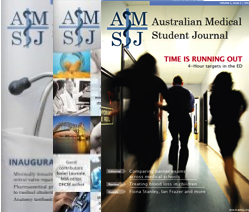MBBS (Hons I)
B App Sci (Physiotherapy)
Dr. Casey Maddren
MBBS (Hons), FRACGP
Dr. Kumara Mendis
MBBS, MSc, MD
Casey Maddren is a General Practitioner who works in an Aboriginal community south of Cairns. At the time of writing she was an academic registrar with the Department of General Practice, University of Sydney, Westmead Clinical School. She is currently a senior lecturer at James Cook University, Cairns.
Kumara Mendis was a Senior Lecturer of Rural Health at the School of Rural Health in Dubbo at the time of writing this article. He has been involved in teaching evidence-based medicine for some time and his subspeciality is medical informatics.
Learning and implementing evidence based practice is an expected component of good medical practice. Synthesising evidence in an effective and timely manner is a skill that is growing in importance and relevance. Evidence based practice is widely included in medical school curricula, and information literacy skills are known to be difficult to acquire. We provide a fresh look at a streamlined approach to evidence based practice, using a ‘real world’ case study.
Introduction
The importance of evidence based practice (EBP) is ever increasing. [1,2] However, the complexities of collecting, interpreting and synthesising information may be time consuming and laborious. [3] Information literacy skills are known to be difficult to learn. [4] In an effort to condense the process, a variety of models have been designed for evidence retrieval, including the 4S, [5] the 5S, [6] and more recently the 6S pyramid (Fig. 1). [7] In this article we will focus on the 6S pyramid and its application to a clinical case.
 The technology explosion of the last decade has increased access to information for clinicians in almost all settings. The rapid development of handheld electronic devices, paired with the licenses to evidence based databases being held by many universities and institutions, results in information being easier to access. The problem then arises of how to find the best information for a clinical scenario in the swiftest manner. The 6S pyramid is useful as it provides a guide showing where to look first; additionally, it tracks the integration of research into clinical practice, with a decision support system at the pinnacle. An example of this is the ‘PrimaryCare Sidebar’ [8] integrating evidence based guidelines into the clinical data already in the patient record. Although the tip of the pyramid is not always readily available, as we step down the pyramid there are a variety of other evidence based tools available, including Dynamed, [9] BMJ Clinical Evidence, [10] and the Therapeutic Guidelines. [11] Further down the pyramid are reliable resources such as PubMed [12] and the Cochrane Database of Systematic Reviews, [13] which are freely available online.
The technology explosion of the last decade has increased access to information for clinicians in almost all settings. The rapid development of handheld electronic devices, paired with the licenses to evidence based databases being held by many universities and institutions, results in information being easier to access. The problem then arises of how to find the best information for a clinical scenario in the swiftest manner. The 6S pyramid is useful as it provides a guide showing where to look first; additionally, it tracks the integration of research into clinical practice, with a decision support system at the pinnacle. An example of this is the ‘PrimaryCare Sidebar’ [8] integrating evidence based guidelines into the clinical data already in the patient record. Although the tip of the pyramid is not always readily available, as we step down the pyramid there are a variety of other evidence based tools available, including Dynamed, [9] BMJ Clinical Evidence, [10] and the Therapeutic Guidelines. [11] Further down the pyramid are reliable resources such as PubMed [12] and the Cochrane Database of Systematic Reviews, [13] which are freely available online.
This article presents a streamlined approach to EBP, demonstrating the multistep process via a clinical case. One of the most difficult aspects of evidence based practice, translating medical jargon and statistics into ‘layman’s terms’ with the goal of empowering the patient to make an informed decision, is demonstrated. Our aim is to demystify EBP and its application for medical students and practitioners, thereby encouraging a wider application in day-to-day clinical work.
Case Details
Mrs SJ is a 62yo Caucasian female who is fairly new to the practice; she presents to discuss the topic of her back pain. SJ reports a three year history of bilateral lumbar radiculopathy; MRI showed degenerative spinal canal stenosis at L5/S1 and nerve conduction studies confirmed neural involvement. Failing a period of conservative measures and continuing to report severe pain, SJ underwent an L5/S1 laminectomy and posterior fusion.
Postoperatively, SJ reported minor relief of her symptoms; she continues to have 6/10 bilateral leg pain on a daily basis. The surgeon advised SJ there was no role for further operative procedures and SJ confirmed she did not want to even consider another procedure. Following the surgery she trialled gabapentin, with minimal effect. Since then she has been attempting to manage her pain with paracetamol, which has only had a partial effect.
Although not under any major financial stress, SJ felt the benefit of the gabapentin did not justify the cost, contributing to cessation of the medication. As an adjunct to pharmacotherapy, SJ had five sessions of physiotherapy addressing postural correction and stretching. She felt there was no benefit from this treatment.
SJ has an otherwise unremarkable medical history, is not on any regular medication and has no allergies. She lives with her husband, who is well. Friends have mentioned other drugs that they found effective for their pain, and she asks why she shouldn’t use them.
Determining a specific, targeted question
Before we seek our answers, we need to define the question/s. [14] This will lead us to a more precise, relevant answer, and save time sifting through irrelevant information.
In patients with chronic lumbar neuropathic pain (radiculopathy), what are the pharmacological options? This question is really what the patient has asked; however, our clinical problem is: what are the pain management options (pharmacological and non-pharmacological) in a patient with radiculopathy who has failed surgical therapy. In practice, we may choose to enquire about the pharmacotherapy about which Mrs SJ has asked; however, a holistic approach to the longterm management of this patient would involve a review of all options, including those that are non-pharmacological. In order to stay focused on the purpose of this article, which is the process of EBP and not the best practice treatment for lumbar radiculopathy, we will focus on pharmacotherapy only.
PICO:
- Population: Chronic radiculopathy, unsuccessful lumbar surgery, menopausal women
- Intervention: Medication, not gabapentin
- Comparator: No medication, paracetamol
- Outcome: Pain reduction and quality of life improvement. [15]
Collecting the evidence
In order to approach this therapy question, we started as high up the pyramid as possible. When creating a search we used keywords that were defined during the formulation of our targeted (PICO) question. Boolean operators (AND, OR, NOT) are also useful and function well in most search engines. Dynamed contained a topic entitled ‘Lumbar spinal stenosis,’ and the treatment section covered some information about medications, but this was not complete. Using BMJ Clinical Evidence (a clinical guideline tool) we searched ‘chronic pain.’ That search led us to the topic ‘chronic pain syndromes,’ and, although there wasn’t a direct answer to our question, under the treatment section we found an international guideline dated 2007.
Now that we knew guidelines existed on the topic, we searched Medline for a more recent version. This led us to three international guidelines. We used the 2010 paper ‘Recommendations for the pharmacological management of neuropathic pain: an overview and literature update’ by Dworkin et al as the primary paper. [16] Unfortunately, as is often the case, evidence specific to our patient was not available.
Determining levels of evidence and strength of recommendation in order to deliver appropriate advice
In order to give valid advice we need to know the strength of the evidence it is based upon, and the size of effect in our population of interest. Various guides exist in order to systemise this process and various methods are commonly used in the literature. The Oxford Centre for Evidence-based Medicine [17] is a well established resource. More recently, The Grading of Recommendations Assessment, Development and Evaluation (GRADE) [18] has been developed with the aim of providing a comprehensive system for grading quality of evidence and strength of recommendations. The resources above provide quality instruction on how to perform the vital step of appraising evidence. Fortunately, this has often already been done for us by others who have summarised the literature, in guidelines or systematic reviews, but it is good to be familiar with the process.
Breaking down the evidence in a real world scenario
Evidence comes from a variety of communities worldwide, and as such, a patient’s specific situation always needs to be taken into account. [22] Various approaches for communicating evidence [23] and mediums for doing so have been evaluated. [24] The way we communicate with patients about risk and effectiveness of treatments can affect their perception and understanding of illness. Communicating with the aid of numerical data, absolute risk (instead of relative risk), both negative and positive perspectives, and with visual aids, all help to improve understanding. [25] Closed loop communication can be used in order to verify understanding. We need to start by translating the evidence into dialogue that would take place between two human beings. This can be helpful in conceptualising the information retrieved. Let’s try…
Doctor: Let’s start by talking about the type of pain you have.
The pain you have is a nerve pain, often called neuropathic pain. This can be due to a lesion or disease. In your case, structures in your lower back are directly irritating nerves. In a simple world you remove the ‘lesion or disease’ and the pain would go away.
Unfortunately, after chronic stimulation the pain message continues to be ‘switched on’ even without a stimulus. This pain can be treated with medications but is often more difficult to manage.
Patient: I totally agree, this pain has been really difficult to manage, and has been getting on top of me for a long time.
Doctor: So your friends have mentioned medications?
Patient: Yes, they have mentioned a few different ones. I’m not sure of the names.
Doctor: There’s a lot of research about medications for the treatment of neuropathic pain, [16] but not a lot have looked at your particular scenario. [26] Of the few medications that have been tested, the evidence suggests only a small amount of benefit. There are some medications that have a lack of efficacy and we should avoid these.
Patient: I am really interested in trying another medication, even if the improvement is only small. Anything that would help me get through the day would be positive.
Doctor: Studies have shown that there are a few main groups of medications that are considered first choice; gabapentin (the one you tried) was one of them. Alternatives include opioids and some antidepressants. We use the antidepressants not because we think you are depressed, but because they have good pain relieving properties for this type of pain. You should know that research found these medications gave meaningful pain relief to around 50 percent of the patients. [23] So, effectively one in two patients. Although this gives us an idea of what to expect, it doesn’t mean it will work for you.
Because of the unclear nature of the evidence, we need to approach the choice of medication carefully, considering your situation. [16]
Patient: So…what are the side effects and how much do these medications cost?
Doctor: Antidepressants, particularly an older group called ‘TCAs’ (tricyclic antidepressants) have been shown to be effective. We don’t fully understand how they work for pain, but do know they provide pain relief in patients who aren’t depressed. [28] On the positive side, they are cheap, are taken once a day and can help with sleep. On the negative side, there are some side effects including dry mouth and constipation. These are not harmful, but annoying, and often resolve with a change in dosage. Rarely, these drugs can cause disturbance to the heart rhythm, and an overdose of these medications is very dangerous to children, so they need to be kept out of reach at all times. Newer antidepressants called SNRIs have shown fewer side effects, but haven’t been studied as thoroughly. [16]
Patient: Besides the heart thing these sound pretty good. I don’t have children at home so that shouldn’t be an issue. Is there anything else on offer?
Doctor: Another group of medications work by slowing down pain impulses; gabapentin is one of these. Although they have proven effectiveness, side effects include dizziness and sedation. As you have mentioned, this is an expensive choice and hasn’t worked for you, so it’s probably not the best option for us at the moment.
Patient: Agreed!
Doctor: Finally, the opioid-like medications are an option. However, I would prefer if we could avoid these. Generally, individuals build tolerance to them and they can be addictive.
Patient: I don’t want to have to rely on it all the time, or have to keep using more of the medication. It sounds like the first option, the antidepressants, is the best, particularly if they are going to help me sleep.
Doctor: Yes, assisting with sleep is a great attribute of TCAs, but it takes a while for full effect, so let’s trial a medication called amitriptyline for six weeks and reassess after that. The medication will cost around A$30 a month. I would like to do an ECG to get an idea of your baseline heart rhythm, and for you to complete two questionnaires in order for us to keep track of your progress: the McGill pain questionnaire [29] and the Short form 36. [30]
Please come back and see me sooner if you have any concerns or develop the side effects we talked about. Also, I would like you to consider other ways this pain can be managed. There are many alternative approaches we should explore, most of which do not include medications.
Conclusion
So, that wasn’t too hard, was it? We defined the question, used a top down approach to the evidence pyramid, and accessed a synthesis of the best literature to answer our question. We made an assessment of the quality of the information available, and attempted to translate ‘doctor speak’ into lay terms. Implementation of the evidence will inevitably lead to further questions. The ongoing process of EBP is illustrated as a cycle (Fig. 2).
Gathering evidence based information should no longer be a chore. Using evidence at any level of the pyramid needs thoughtful consideration, requiring close scrutiny of the methods of evidence generation and the method of appraisal. Due to the increasing amount of evidence being published, synthesis and weighing of existing evidence can serve to provide a more comprehensive and relevant source of evidence based recommendations. The streamlined pyramid approach can be skimmed during consultations or scrutinised for assignments.
So the next time a patient (or an examiner!) throws you a curveball, use EBP to find the comprehensive answer they deserve.
Acknowledgements
The authors would like to thank Dr Morris Aziz for his contribution on the topic.
Conflict of interest
None declared.
Correspondence
J Dannaway: jdan9820@uni.sydney.edu.au
References
[1] Dawes M, Summerskill W, Glasziou P, Cartabellotta A, Martin J, Hopayian K, et al. Sicily statement on evidence-based practice. BMC Medical Education. 2005; 5(1):1.
[2] Sackett DL, Rosenberg WMC. On the need for evidence-based medicine. Journal of Public Health. 1995; 17(3):330 –334.
[3] Haynes B, Haines A. Barriers and bridges to evidence based clinical practice. BMJ. 1998 Jul 25;317(7153):273–6.
[4] Hofer AR, Townsend L, Brunetti K. Troublesome Concepts and Information Literacy: Investigating Threshold Concepts for IL Instruction. Portal: Libraries and the Academy. 2012; 12(4):387–405.
[5] Haynes RB. Of studies, syntheses, synopses, and systems: the “4S” evolution of services for finding current best evidence. ACP J. Club. 2001 Apr;134(2):A11–13.
[6] Haynes RB. Of studies, syntheses, synopses, summaries, and systems: the “5S” evolution of information services for evidence-based healthcare decisions. Evidence Based Medicine. 2006; 11(6):162–4.
[7] DiCenso A, Bayley L, Haynes RB. Accessing pre-appraised evidence: fine-tuning the 5S model into a 6S model. Evidence based nursing. 2009; 12(4):99–101.
[8] PrimaryCare Sidebar. [Accessed 2013 Aug 26]. Available from: http://www.racgpoxygen.com.au/products/
[9] Dynamed. [Accessed 2011 Dec 19]. Available from: http://dynamed.ebscohost.com/
[10] BMJ Clinical Evidence. [Accessed 2011 Dec 19]. Available from: http://clinicalevidence.bmj.com/ceweb/index.jsp
[11] Therapeutic Guidelines. [Accessed 2011 Dec 19]. Available from: http://www.tg.org.au/
[12] PubMed. [Accessed 2011 Dec 19]. Available from:http://www.ncbi.nlm.nih.gov/pubmed/
[13] The Cochrane Collaboration. Cochrane Reviews. [Accessed 2011 Dec 19]. Available from: http://www.cochrane.org/cochrane-reviews
[14] Centre for Evidence Based Medicine. Asking focused questions. [Accessed 2011 Dec 19]. Available from: http://www.cebm.net/index.aspx?o=1036
[15] Salisbury J, Glasziou P, Del Mar C, Salisbury J. Evidence-based practice workbook. Oxford: Blackwell; 2007.
[16] Dworkin RH, O’Connor AB, Audette J, Baron R, Gourlay GK, Haanpää ML, et al. Recommendations for the pharmacological management of neuropathic pain: an overview and literature update. Mayo Clinic Proceedings. 2010. p. S3.
[17] CEBM (Centre for Evidence-Based Medicine). [Accessed 2011 Dec 19]. Available from: http://www.cebm.net/index.aspx?o=1001
[18] The grading of recommendations assessment, development and evaluation (GRADE). [Accessed 2012 Dec 19]. Available from: http://www.gradeworkinggroup.org/index.htm
[19] Tran DQH, Duong S, Finlayson RJ. Lumbar spinal stenosis: a brief review of the nonsurgical management. Can J Anaesth. 2010 Jul;57(7):694–703.
[20] Baron R, Freynhagen R, Tölle TR, Cloutier C, Leon T, Murphy TK, et al. The efficacy and safety of pregabalin in the treatment of neuropathic pain associated with chronic lumbosacral radiculopathy. Pain. 2010 Sep;150(3):420–7.
[21] Attal N, Cruccu G, Baron R, Haanpää M, Hansson P, Jensen TS, et al. EFNS guidelines on the pharmacological treatment of neuropathic pain: 2010 revision. European Journal of Neurology. 2010; 17(9):1113–e88.
[22] Centre for Evidence Based Medicine. Making a decision. [Accessed 2011 Dec 19]. Available from: http://www.cebm.net/index.aspx?o=1854
[23] Epstein RM, Alper BS, Quill TE. Communicating evidence for participatory decision making. JAMA: The Journal of the American Medical Association. 2004; 291(19):2359.
[24] Trevena LJ, Barratt A, Butow P, Caldwell P. A systematic review on communicating with patients about evidence. Journal of Evaluation in Clinical Practice. 2006; 12(1):13–23.
[25] Paling J. Strategies to help patients understand risks. BMJ. 2003; 327(7417):745–8.
[26] Attal N, Martinez V. Recent Developments in the Pharmacological Management of Neuropathic Pain. European Neurological Journal. 2010
[27] OʼConnor AB. Neuropathic Pain: Quality-of-Life Impact, Costs and Cost Effectiveness of Therapy. PharmacoEconomics. 2009;27(2):95–112.
[28] Max MB, Culnane M, Schafer SC, Gracely RH, Walther DJ, Smoller B, et al. Amitriptyline relieves diabetic neuropathy pain in patients with normal or depressed mood. Neurology. 1987 Apr;37(4):589–96.
[29] Melzack R, Katz J. The McGill Pain Questionnaire: appraisal and current status. Guilford Press; 2001.
[30] Ware Jr JE. SF-36 health survey update. Spine. 2000;25(24):3130–9.
 Download PDF
Download PDF Read online
Read online You can subscribe by e-mail to receive each issue when it's published.
You can subscribe by e-mail to receive each issue when it's published.
 Download the issue
Download the issue Print this extract
Print this extract Share on Facebook
Share on Facebook


